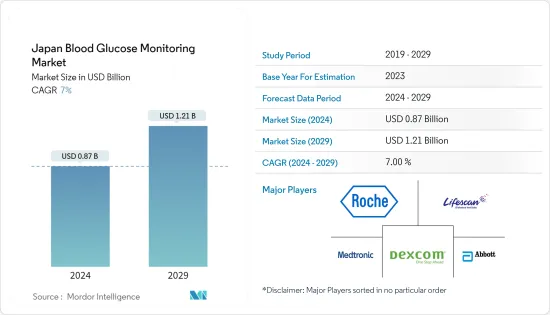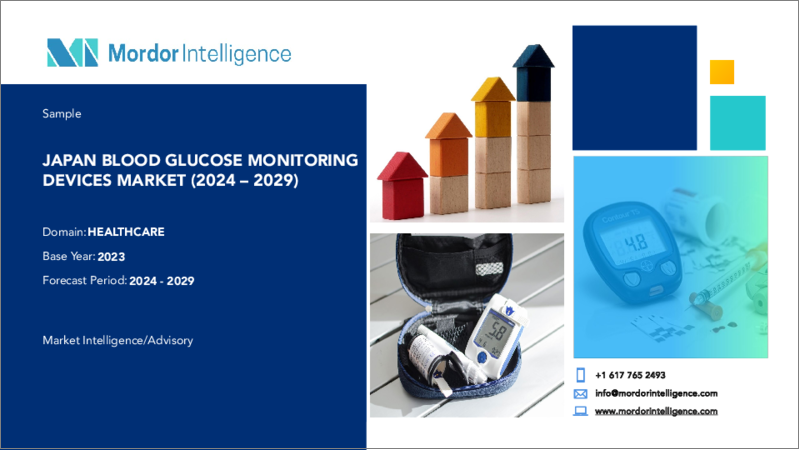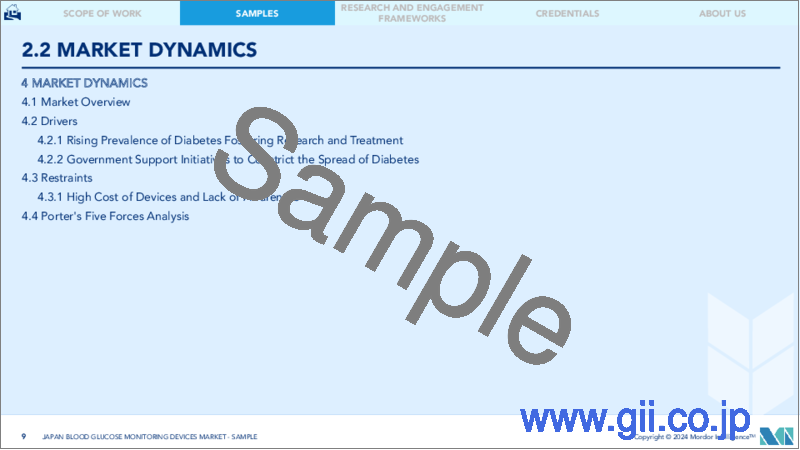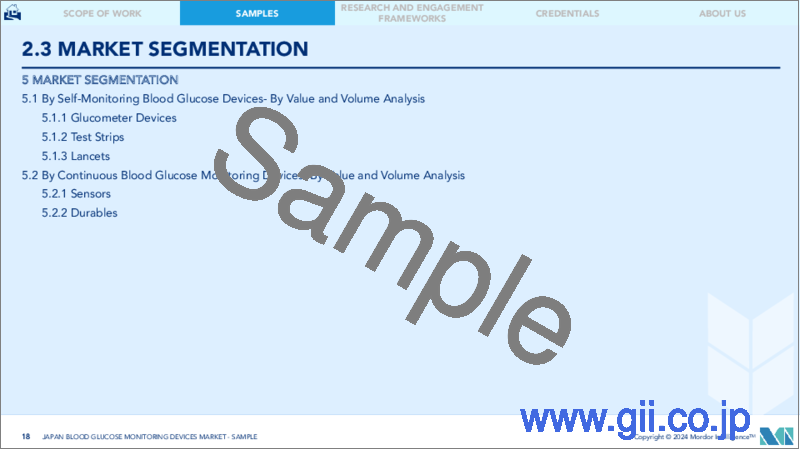|
|
市場調査レポート
商品コード
1445815
日本の血糖モニタリング(BGM): 市場シェア分析、業界動向と統計、成長予測(2024~2029年)Japan Blood Glucose Monitoring - Market Share Analysis, Industry Trends & Statistics, Growth Forecasts (2024 - 2029) |
||||||
カスタマイズ可能
適宜更新あり
|
|||||||
| 日本の血糖モニタリング(BGM): 市場シェア分析、業界動向と統計、成長予測(2024~2029年) |
|
出版日: 2024年02月15日
発行: Mordor Intelligence
ページ情報: 英文 70 Pages
納期: 2~3営業日
|
全表示
- 概要
- 目次
日本の血糖モニタリング(BGM)市場規模は、2024年に8億7,000万米ドルと推定され、2029年までに12億1,000万米ドルに達すると予測されており、予測期間(2024年から2029年)中に7%のCAGRで成長します。

COVID-19パンデミックは、ヘルスケア提供者と糖尿病患者との間の仮想協議や糖尿病技術の利用を通じて、糖尿病機器の提供におけるイノベーションを継続および拡大する機会を浮き彫りにしました。危機管理により、患者と医療提供者の両方から遠隔医療に対する前例のない関心が生まれ、長年にわたる多くの規制障壁が取り除かれました。このように、COVID-19の発生により、日本の糖尿病治療薬市場の成長が加速しました。
1型糖尿病が免疫系の機能不全によって引き起こされるのに対して、2型糖尿病は座りっぱなしの生活習慣に関連しており、その結果、インスリンに対する先天的な抵抗性が生じます。したがって、1型糖尿病はインスリンを必要とする糖尿病であり、2型糖尿病はインスリン依存性糖尿病になります。日本は世界でも有数の高齢者人口を抱えており、2型糖尿病を発症しやすい国です。日本では高齢化が進み、糖尿病の有病率も増加しています。心血管疾患、腎臓障害、その他多くの症状などの悪影響を回避するために、血糖値の監視と管理が増加しています。
したがって、前述の要因により、調査対象の市場は分析期間中に成長すると予想されます。
日本の血糖モニタリング市場動向
日本全体で増加する1型糖尿病人口
糖尿病は世界の流行病として浮上しています。 IDFの2021年のデータによると、日本には約1,100万人の糖尿病患者がいます。 日本では高齢化が進むにつれて、糖尿病の有病率も増加しています。心血管疾患、腎臓障害、その他多くの状態などの悪影響を回避するために、血糖値の監視と管理の必要性が増加しています。
日本における糖尿病患者の増加は、病気になりやすい高齢者の増加と、運動不足や不規則な食生活による肥満の増加が原因と考えられています。生活習慣病の予防を目的として2008年に導入されたメタボリックシンドローム検査の結果をもとに、医療機関を受診し、診断を受ける人が増えていることも要因の一つです。日本社会の高齢化に伴い、糖尿病患者は今後さらに増加すると予想されています。
上記の要因の結果、ロシアにおける調査対象市場の成長が予想されます。
継続的血糖モニタリングは、日本の血糖モニタリング市場で最高のCAGRを保持しています。
糖尿病は、失明、神経障害、腎臓病、心筋梗塞、脳卒中を引き起こす可能性がある複雑な慢性疾患です。患者は、症状の悪化や合併症の発症を避けるために、毎日血糖値を管理する必要があります。近年、CGMシステムと連携したスマートフォンなどの機器上でリアルタイム血糖測定(CGM)を行うためのアプリが開発され、日本でも利用され始めています。従来の遡及的 CGMと比較して、CGMアプリを使用すると患者の血糖コントロールが向上し、2型糖尿病(DM)の進行を遅らせ、合併症を予防することが期待されます。
持続グルコースモニタリングセンサーは、グルコースオキシダーゼを使用して血糖値を検出します。グルコースオキシダーゼはグルコースを水素ペルオキシダーゼに変換し、これがセンサー内のプラチナと反応して、送信機に伝達される電気信号を生成します。センサーは、継続的な血糖値監視装置の最も重要な部分です。センサーの精度を向上させる技術の進歩により、予測期間中のセグメントの成長が促進されると予想されます。
毎月の透析医療費は一人当たり平均約40万、国全体で年間約1兆6,000億で、全医療費の約4%を占めます。したがって、糖尿病のリスクがある人の日常生活を改善し、すでに糖尿病に罹患している人の悪化を防ぐことが重要です。
ロシアにおける糖尿病有病率の増加と上記の要因により、予測期間中のセグメントの成長が促進される可能性があります。
日本の血糖モニタリング業界の概要
血糖モニタリング市場は非常に細分化されており、市場に存在する大手メーカーはほとんどありません。 CGMデバイス市場は、Dexcom、Medtronics、Abbott、Senseonicsなどの大手企業によって独占されています。 BGMデバイスの市場は、Roche、LifeScan、Arkray、Ascensiaなどのより一般的な企業で構成されています。最近の技術革新は、企業が市場での存在感を強化するのに役立ちました。
その他の特典
- エクセル形式の市場予測(ME)シート
- 3か月のアナリストサポート
目次
第1章 イントロダクション
- 調査の前提条件と市場の定義
- 調査範囲
第2章 調査手法
第3章 エグゼクティブサマリー
第4章 市場力学
- 市場概要
- 促進要因
- 抑制要因
- ポーターのファイブフォース分析
- 供給企業の交渉力
- 消費者の交渉力
- 新規参入業者の脅威
- 代替製品やサービスの脅威
- 競争企業間の敵対関係の激しさ
第5章 市場セグメンテーション
- 血糖自己測定装置
- 血糖計デバイス
- テストストリップ
- ランセット
- 持続血糖測定装置
- センサー
- 耐久財(受信機および送信機)
第6章 市場指標
- 1型糖尿病の人口
- 2型糖尿病の人口
第7章 競合情勢
- 企業プロファイル
- Abbott Diabetes Care
- Roche Holding AG
- LifeScan
- Dexcom Inc.
- Medtronic PLC
- Arkray Inc.
- Ascensia Diabetes Care
- Agamatrix Inc.
- Bionime Corporation
- Acon Laboratories Inc.
- Trivida Functional Medicine
- Senseonics
- 企業シェア分析
- Self-monitoring Blood Glucose Devices
- Abbott Diabetes Care
- Roche Holding AG
- LifeScan
- Continuous Glucose Monitoring Devices
- Dexcom Inc.
- Medtronic PLC
- Abbott Diabetes Care
- Self-monitoring Blood Glucose Devices
第8章 市場機会と将来の動向
The Japan Blood Glucose Monitoring Market size is estimated at USD 0.87 billion in 2024, and is expected to reach USD 1.21 billion by 2029, growing at a CAGR of 7% during the forecast period (2024-2029).

During the COVID-19 pandemic, the number of Japanese victims was lower than in other countries, possibly due to gene differences, aspects of Japanese culture, and coagulation system characteristics that are less potent in Japanese than in Caucasians. To relieve overburdened hospitals, the Osaka prefectural government classified patients as mild, moderate, or severe and distributed them among various alternative accommodations. Patients in hospitals were managed in accordance with national government guidelines. Concentrating on moderate patients, i.e., those whose oxygen saturation levels were acceptable despite the presence of characteristics on computed tomography.
The pandemic also highlighted opportunities for continuing and expanding innovations in the delivery of diabetes devices, through virtual consultations between healthcare providers and people with diabetes, and the use of diabetes technology. Crisis management has created unprecedented interest in remote care from both patients and providers and removed many long-standing regulatory barriers. Thus, the COVID-19 outbreak increased the Japanese diabetes drugs market's growth.
While Type 1 diabetes is caused by an immune system malfunction, Type 2 diabetes is linked to leading a sedentary lifestyle, which results in the development of inherent resistance to insulin. Hence, Type 1 diabetes can be characterized as insulin-requiring, while Type 2 diabetes can be characterized as insulin-dependent diabetes. Japan has one of the largest elderly populations in the world which is more susceptible to the onset of type 2 diabetes. As Japan's population continues to age, the prevalence of diabetes increases as well. The monitoring and management of blood glucose levels are on the rise, to avoid negative consequences, such as cardiovascular diseases, kidney disorders, and many other conditions.
Therefore, owing to the aforementioned factors the studied market is anticipated to witness growth over the analysis period.
Japan Blood Glucose Monitoring Market Trends
Increasing Type-1 diabetes population across Japan
Diabetes has emerged as a global epidemic; Japan has around 11 million people with diabetes, according to IDF 2021 data. While Type 1 diabetes is caused by an immune system malfunction, Type 2 diabetes is linked to leading a sedentary lifestyle, resulting in inherent resistance to insulin. Hence, Type 1 diabetes can be characterized as insulin-requiring, while Type 2 diabetes can be characterized as insulin-dependent diabetes. Japan has one of the largest elderly populations in the world, which is more susceptible to the onset of Type 2 diabetes. As Japan's population continues to age, the prevalence of diabetes also increases. Monitoring and managing blood glucose levels are on the rise to avoid negative consequences, such as cardiovascular diseases, kidney disorders, and many other conditions.
The rise in diabetes cases in Japan is thought to be due to an increase in the number of older adults, who are more vulnerable to disease, and an increase in obesity due to a lack of exercise and irregular eating habits. Another reason is that more people have been diagnosed with the disease after being directed to a medical facility based on the results of the metabolic syndrome examination, which was introduced in 2008 to prevent lifestyle-related diseases. Diabetes cases are expected to increase even further in the coming years as Japan's society ages.
As a result of the factors above, the growth of the studied market in Russia is anticipated.
Continuous Glucose Monitoring Holds Highest CAGR in Japan Blood Glucose Monitoring Market.
Diabetes is a complex and chronic disease that can cause blindness, neuropathy, kidney disease, myocardial infarction, or stroke. Patients must control their glucose levels daily to avoid aggravation and the onset of complications. Apps for real-time continuous glucose monitoring (CGM) on smartphones and other devices linked to CGM systems have recently been developed, and such CGM apps are also being used in Japan. Compared to traditional retrospective CGM, using CGM apps improves patients' blood glucose control, which is expected to help slow the progression of Type 2 diabetes mellitus (DM) and prevent complications.
Continuous glucose monitoring sensors use glucose oxidase to detect blood sugar levels. Glucose oxidase converts glucose to hydrogen peroxidase, which reacts with the platinum inside the sensor, producing an electrical signal to be communicated to the transmitter. Sensors are the most important part of continuous glucose monitoring devices. Technological advancements to improve the accuracy of the sensors are expected to drive segment growth during the forecast period.
Monthly dialysis medical costs average around 400,000 per person and around 1.6 trillion annually for the country, accounting for roughly 4% of all medical expenditures. It is, therefore, critical to improve the daily habits of those at risk of diabetes and to keep those who have already contracted the disease from worsening.
The increased diabetic prevalence in Russia and the above factors will likely drive segment growth during the forecast period.
Japan Blood Glucose Monitoring Industry Overview
The blood glucose monitoring market is highly fragmented, with few major manufacturers present in the market. The CGM devices market is dominated by major players, like Dexcom, Medtronics, Abbott, and Senseonics. The market for BGM devices comprises more generic players like Roche, LifeScan, Arkray, Ascensia, etc. Technological innovations in the recent past helped companies to strengthen their market presence.
Additional Benefits:
- The market estimate (ME) sheet in Excel format
- 3 months of analyst support
TABLE OF CONTENTS
1 INTRODUCTION
- 1.1 Study Assumptions and Market Definition
- 1.2 Scope of the Study
2 RESEARCH METHODOLOGY
3 EXECUTIVE SUMMARY
4 MARKET DYNAMICS
- 4.1 Market Overview
- 4.2 Drivers
- 4.3 Restraints
- 4.4 Porter's Five Forces Analysis
- 4.4.1 Bargaining Power of Suppliers
- 4.4.2 Bargaining Power of Consumers
- 4.4.3 Threat of New Entrants
- 4.4.4 Threat of Substitute Products and Services
- 4.4.5 Intensity of Competitive Rivalry
5 MARKET SEGMENTATION
- 5.1 Self-monitoring blood glucose devices
- 5.1.1 Glucometer Devices
- 5.1.2 Test Strips
- 5.1.3 Lancets
- 5.2 Continuous blood glucose monitoring devices
- 5.2.1 Sensors
- 5.2.2 Durables (Receivers and Transmitters)
6 MARKET INDICATORS
- 6.1 Type-1 Diabetes population
- 6.2 Type-2 Diabetes population
7 COMPETITIVE LANDSCAPE
- 7.1 COMPANY PROFILES
- 7.1.1 Abbott Diabetes Care
- 7.1.2 Roche Holding AG
- 7.1.3 LifeScan
- 7.1.4 Dexcom Inc.
- 7.1.5 Medtronic PLC
- 7.1.6 Arkray Inc.
- 7.1.7 Ascensia Diabetes Care
- 7.1.8 Agamatrix Inc.
- 7.1.9 Bionime Corporation
- 7.1.10 Acon Laboratories Inc.
- 7.1.11 Trivida Functional Medicine
- 7.1.12 Senseonics
- 7.2 COMPANY SHARE ANALYSIS
- 7.2.1 Self-monitoring Blood Glucose Devices
- 7.2.1.1 Abbott Diabetes Care
- 7.2.1.2 Roche Holding AG
- 7.2.1.3 LifeScan
- 7.2.2 Continuous Glucose Monitoring Devices
- 7.2.2.1 Dexcom Inc.
- 7.2.2.2 Medtronic PLC
- 7.2.2.3 Abbott Diabetes Care
- 7.2.1 Self-monitoring Blood Glucose Devices






